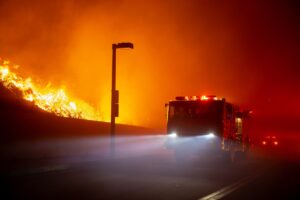Physical Address
23,24,25 & 26, 2nd Floor, Software Technology Park India, Opp: Garware Stadium,MIDC, Chikalthana, Aurangabad, Maharashtra – 431001 India
Physical Address
23,24,25 & 26, 2nd Floor, Software Technology Park India, Opp: Garware Stadium,MIDC, Chikalthana, Aurangabad, Maharashtra – 431001 India

Recent wildfires in Southern California have fueled debates around their causes, with some denying the role of climate change. A climate sceptic, Steve Milloy, recently posted a tweet claiming that Santa Ana wind-driven fires are natural and predate emissions, that Los Angeles has seen no discernible climate change, and that “green policies” have led to overgrown, fire-prone vegetation.
X Post:
Claim 1: There has been no discernible climate change in the Los Angeles area.
Fact: False. Scientific data shows that Los Angeles and Southern California have experienced significant warming over the past century. According to California’s Fourth Climate Change Assessment and data from NOAA, the region has seen an evident rise in average temperatures, with extreme heat days becoming more frequent and prolonged.
This warming trend directly impacts wildfire risks. Higher temperatures dry out vegetation faster, turning it into tinderbox conditions. Research from the University of California, Los Angeles (UCLA) confirms that this warming accelerates fire spread by increasing flammable vegetation and decreasing soil moisture. These changes, driven by climate change, have made fires more intense and more challenging to control. While regional climate variability exists, dismissing the clear evidence of long-term warming trends in Los Angeles ignores the bigger picture.
Claim 2: Santa Ana wind-driven fires have been reported since the 19th century.
Fact: Misleading. Yes, Santa Ana winds are natural phenomena that have been documented since the 19th century. However, Milloy’s argument fails to account for how climate change exacerbates the conditions these winds create. Santa Ana winds are dry, gusty winds that blow from the interior deserts toward the coast, naturally fanning flames and spreading fires. But while the winds haven’t changed significantly, climate-driven factors like increased temperatures and prolonged droughts have intensified their effects.
A study published in Environmental Research Letters analysed climate change’s impact on California’s vegetation flammability. The study found that climate change has made vegetation flammable by increasing evaporation rates and reducing precipitation. These changes amplify the effects of Santa Ana winds, turning what might have been smaller fires a century ago into the devastating Wildfires we see today. Claiming that historical fires prove climate change plays no role ignores the critical connection between modern climate trends and fire severity.
Claim 3: Green efforts, such as preserving natural habitats and limiting urban sprawl, have led to overgrown and fire-ready brush.
Fact: False. Milloy’s claim touches on a valid concern about fire management but misrepresents the role of “green efforts.” Vegetation can indeed become overgrown without proper management. However, climate change, not environmental policies, is the primary driver behind the increasingly fire-prone conditions in California. Cal Fire and the U.S. Forest Service reports emphasise the importance of responsible land management, such as controlled burns and vegetation clearing, to reduce fire risk. Environmental groups often support these practices and are part of responsible land management, not a rejection of it.
Furthermore, restricting urban sprawl—often framed as a “green policy”—is essential for reducing fire risk in the wildland-urban interface (WUI), where human activity significantly increases the likelihood of fire ignitions. Expanding development into fire-prone areas can worsen the problem by exposing more people and structures to danger.
Milloy points to overgrown vegetation as a symptom of more prolonged, hotter droughts and shifts in seasonal rainfall patterns directly linked to climate change. Blaming “green policies” for these natural processes is an oversimplification that distracts from addressing the real problem.
The Bigger Picture: Climate Change and Wildfires
The science is clear: climate change is not the sole cause of wildfires but acts as a force multiplier. California’s wildfire season is now nearly year-round, driven by higher temperatures, reduced snowpack, and prolonged droughts. This urgent situation demands our immediate attention and action.
Santa Ana winds have always been a factor, but they now operate in a landscape fundamentally altered by climate change. Due to a combination of human activity and changing environmental conditions, fires that might once have been contained are now more likely to become catastrophic. This emphasises the need for responsible land management and a collective effort to reduce our environmental impact.
Policies aimed at reducing urban sprawl and preserving ecosystems are not the villains here; they are part of the solution. Rising greenhouse gas emissions and inadequate investment in fire prevention and response infrastructure are the real culprits.
Steve Milloy’s claims oversimplify and misrepresent the causes of California’s wildfires, ignoring the overwhelming evidence of climate change’s role in worsening fire conditions. While historical fires and natural phenomena like Santa Ana winds are real, dismissing the impact of a warming climate only hinders our ability to address this growing crisis.
References:
https://climate.nasa.gov/files/LAHeatWaves-JournalArticle.pdf
https://www.bbc.com/weather/articles/cg7r7rrex8no
https://iopscience.iop.org/article/10.1088/1748-9326/ab83a7
https://newsroom.ucla.edu/releases/risk-of-massive-wildfires-continues-to-grow
Photo: California Governor’s X Post
Banner image:
Source: Los Angels Fire Department X Post